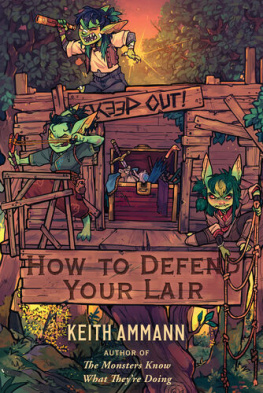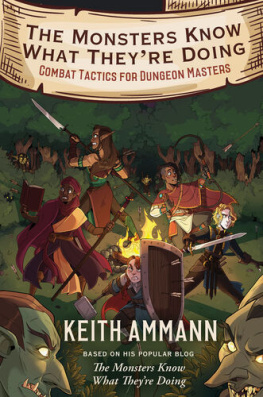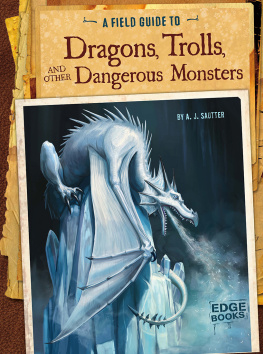Contents
Guide
How to Defend Your Lair
Keith Ammann
Author of The Monsters Know What Theyre Doing
Publishers Notice
The publisher has provided this ebook to you without Digital Rights Management (DRM) software applied so that you can enjoy reading it on your personal devices. This ebook is for your personal use only. You may not print or post this ebook, or make this ebook publicly available in any way. You may not copy, reproduce, or upload this ebook except to read it on your personal devices.
Copyright infringement is against the law. If you believe the copy of this ebook you are reading infringes on the authors copyright, please notify the publisher at: simonandschuster.biz/online_piracy_report.
ALSO BY KEITH AMMANN
The Monsters Know What Theyre Doing
MOAR! Monsters Know What Theyre Doing
Live to Tell the Tale

www.SimonandSchuster.com
Copyright 2022 by Keith Ammann
All rights reserved, including the right to reproduce this book or portions thereof in any form whatsoever. For information, address Saga Press Subsidiary Rights Department, 1230 Avenue of the Americas, New York, NY 10020.
First Saga Press hardcover edition December 2022
SAGA PRESS and colophon are trademarks of Simon & Schuster, Inc.
For information about special discounts for bulk purchases, please contact Simon & Schuster Special Sales at 1-866-506-1949 or .
The Simon & Schuster Speakers Bureau can bring authors to your live event. For more information or to book an event, contact the Simon & Schuster Speakers Bureau at 1-866-248-3049 or visit our website at www.simonspeakers.com.
Jacket design by Emma A. Van Deun
Jacket illustration by Lio Pressland
Author photograph by Jen C. Marshall
Library of Congress Cataloging-in-Publication Data is available.
ISBN 978-1-9821-7135-3
ISBN 978-1-9821-7137-7 (ebook)
It may be said that I fear too much. Surely, considering the state we stand in, I think it less danger to fear too much than too little.
Sir Francis Walsingham
INTRODUCTION
The world is a dangerous placeespecially when youre up to no good.
But even a person of unblemished character and sterling repute may make enemies, especially among those of more blemished character and more tarnished repute. Perhaps your deeds have intruded on someone elses interests, or soon will, and theyve resolved to stop you. Perhaps the wealth youve amassed is becoming an irresistible temptation to larcenous minds. Perhaps youre making discoveries that others would prefer to keep under wrapsor would appropriate for purposes of their own.
Whether youre a rampaging monster, a renowned hero, a despised tyrant, an ambitious schemer, a paranoid recluse, or the current possessor of the Golden MacGuffin, someones going to come at you. Probably more than one someone. You need to be ready.
You need a lair.
When youre writing your own adventure material for a tabletop roleplaying game from scratch, you have all kinds of freedom. You decide what environments the player characters will travel through. You decide what villains theyll fight, what those villains plans are, and what kind of minions those villains will have. You decide what kind of help and hindrances the PCs will encounter along the way. And heres a point of underrated importance: You draw the maps.
If youre throwing your PCs and monsters at each other in a plain, rectangular room, or designing your dungeons as an essentially (or literally) random maze, youre missing all kinds of opportunities to add flavor, challenge, complexity, and narrative. Designing a well-defended stronghold gives you opportunities to show off how your antagonists think and what they consider important.
In The Monsters Know What Theyre Doing: Combat Tactics for Dungeon Masters and MOAR! Monsters Know What Theyre Doing, I break down the stat blocks of fifth edition Dungeons & Dragons monsters to determine their unique tactics and styles of fighting so that every combat encounter with a different monster or villain is a distinct experience. In this book, I discuss how to create the environments in which those combat encounters take place so that they feel as real and alive as the monsters and villains do. Outfighting the enemy is no longer enough: PCs will have to outthink the enemy as well. Pushing your players to consider how to solve problems without running at them head-on, weapons swinging and fireballs blasting, is as much a gift to them as it is an obstacle, because some of the best gaming memories are born from the cunning plans that come together to produce success against the oddsand from the ones that go riotously sideways.
Having a lair is all about establishing surroundings that give you every available edge over those who want to kill you and take your stuff. For example, in The Monsters Know What Theyre Doing, I make three observations that are essential to understanding how kobolds fight: First, by necessity, they fight in darkness or underground, not under broad daylight. Second, theyre small and weak yet instinctively coordinated, so they seek strength in numbers. Third, they make use of traps. The D&D sourcebook Volos Guide to Monsters, in a delightful section on kobold lairs, sensibly depicts a kobold lair as an anthill of twisty subterranean passages, full of traps and choke points, in which larger creatures will get lost, stuck, or both. Its customized to maximize kobolds comparative advantage over their likely foes. The foes are big, and kobolds are small; therefore, the passages are small. The foes may not be able to see in the dark, and the kobolds can; therefore, the passages are unlit. The terrain is familiar to the kobolds, unfamiliar to their foes; therefore, the passages are full of traps to punish the unwary and ignorant.
Designing defensible space is both art and science, with more than two millennia of recorded experimentation to draw from. The ideas behind todays best security practices date back to the building of the earliest ringworks. Introducing fantasy elements to your game setting doesnt invalidate those ideas. Just the opposite: It presents new options and new challenges, to both the defender and the attacker. Overlook the fundamentals of security planning, and your villains will get rolled. Pile on an implausible, unsustainable number of defenses, however, and the games not fun anymore. Its a delicate balance: A defended area has to be locked down tightly enough to repel any reasonable number of ordinary invaders, but extraordinary invaders, such as a group of PC adventurers, have to be able to make their way in somehow.
Building the perfect lair begins with the unglamorous step of a behind-the-scenes security assessment. As the Dungeon Master, ask yourself what your monsters and nonplayer characters need to protect, whom or what they need to protect it from, and what resources they have to protect it with. From there, move on to their unique methods of detecting, deterring, and responding to external threats. Decide how they might employ spies, concealment, and traps, if at all, and how many layers deep their defenses can be. Determine what climate and terrain features they can use to their advantage. Populate the lairs environs with dangerous creatures, both loyal minions and opportunistic predators present for reasons of their own that have nothing to do with the defense of the lair but add interest to the experience of getting there. If your antagonists employ a guard force, decide how large it will be and how to deploy it. Figure out how much magical protection theyll have access to, based on the prevalence of magic in your setting. Draw up a battle plan that the defenders will follow. Decide whether theyll take prisoners and what theyll do with them.
















